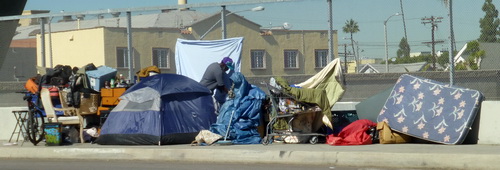City Takes Some Steps to Confront Homeless Crisis
Leslie Evans
Five months after the Los Angeles city government began to debate new ordinances to confront our deepening homeless calamity, the City Council on November 18 announced its first steps. The L.A. Times in an editorial the next day declared the effort “a start, even if some of the measures are anemic.”
In September the Council had promised to raise $100 million to abate homelessness in the city. The county supervisors pledged their own $100 million fund. As of the November 18 announcements the kitty contained only $16 million. Specific proposals were to set aside vacant city buildings as winter shelters and to seek out parking lots where people living in cars and RVs could camp at night, possibly with porta potties supplied by the city. These are promising beginnings, but Council members pointed out that many bureaucratic hurdles stood in the way of assigning buildings to such uses and nothing was likely to happen until the new year. One L.A. Times report suggested that the parking lots under consideration were those of churches and not city property.
The legislators were spurred by the impending arrival of the historically large El Niño rainstorms in January which may actually drown homeless people living in culverts and river beds.
Other goals were to expand warehouse space to serve both for voluntary storage of street people’s possessions and to hold property seized in camp cleanups. At present there is only one such warehouse, located in Skid Row. Under the new ordinances homeless property can only be seized if there is a city storage facility within two miles of the demolished camp.
The City Council’s Homeless Committee is supposed to submit its full proposal in January so it is unlikely that the new ideas will get far before then.
Mayor Garcetti had previously said he would declare a homeless emergency, similar to those for natural disasters. He has decided not to go that far at this time. It is unclear whether such a declaration would generate any state or federal financial aid, but retired UCLA law professor Gary Blasi, a frequently quoted specialist on homelessness, told the Times that such a declaration would allow the Mayor to take some simple direct steps without having to wait for long debates in the City Council:
“For example, the mayor could ensure that people sleeping on sidewalks are provided with wooden pallets or other means of getting their bedding and clothing off the cold, wet ground, or providing tarps that can supplement the leaky tents and makeshift shelters in keeping them dry.”
Long-term Options
The most successful strategy in reducing chronic homelessness has been Housing First. This means not demanding of mentally ill or addicted street people that they go clean before being offered housing. Getting the chronic cases into housing as the first step has been far more successful than trying to cure their addictions or mental conditions while they are still camped in alleys and under bridges. And where such housing, generally requiring social work supervision, has been provided it has greatly reduced the costs of leaving these people on the streets. Charges for frequent emergency room care and police intervention when untreated people get out of control have been proven to be far greater than the costs of housing and preventive care.
At the same time, Housing First, given the large initial costs of creating or allocating the housing, cannot realistically take the extremely large numbers of unsheltered off the streets. A second policy arrow in the official quiver needs to be expanding the shelter system, and with shelters that can take people in for months, not just days.
Here it is helpful to contrast New York’s approach to the homeless to our city’s. In L.A. County as of January 2015 there were 44,359 homeless people, of which 31,018 or 70% were unsheltered, living on the streets. For the city the numbers were 25,686 with 17,667 unsheltered, at 69%. New York, in contrast, has invested hugely in its semi-long-term shelter system. Its numbers are 59,305 total homeless, of whom the city claims only 3,300, or 5.6%, are unsheltered. New York this year is spending about $950 million on its shelter system, while L.A. last year spent $100 million of which 87% went for police and emergency Fire Department ambulances, very little for either housing or shelters.
New York on November 17 announced it plans to invest $3 billion in housing for the homeless, creating 15,000 new units over the next fifteen years, or a steady $200 million a year. Half will be newly built and the other half are to be purchased by the city and reallocated as supportive housing for the homeless.
We can see from this that New York is taking this problem more seriously than Los Angeles, and after beginning with its extensive shelter operation is now expanding into specialized housing for the unsheltered and to remove a fair number from the sheltered population into permanent housing.
One thing that makes the problem in Los Angeles more intractable, in addition to the small amounts of money devoted to it, is the warm weather. Without punishing winters Los Angeles has attracted an unusually large percentage of long-term chronic homeless individuals with mental or addiction problems that make them resistant to leaving the streets and difficult to treat. We hope that our city and county in January will begin to take more aggressive steps, both for humanitarian reasons and because the spread of homeless camps undeniably constitutes a public health, crime, and trash problem.
Comments
Leave a Reply
You must be logged in to post a comment.




